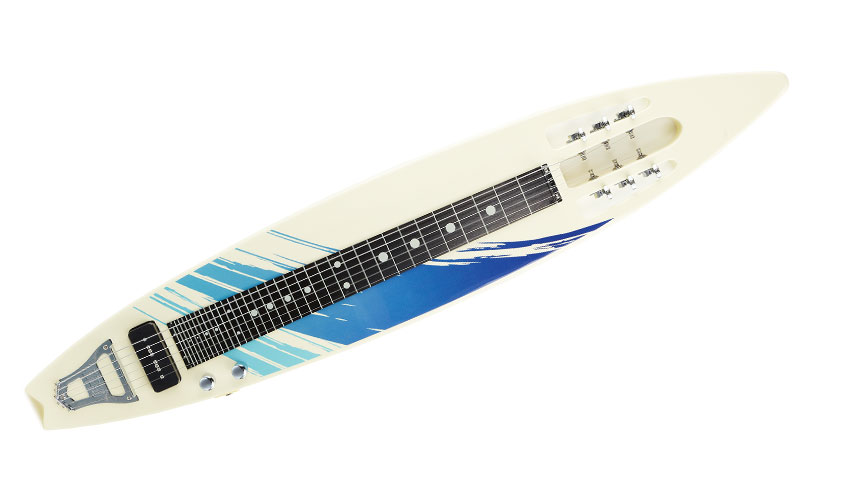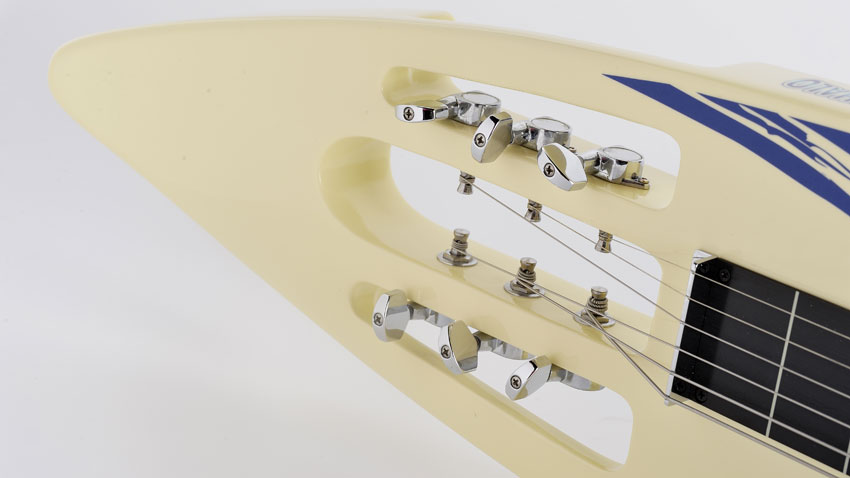MusicRadar Verdict
Like pineapple on pizza, lap steel can be something of an acquired taste, but the Mahalo is the perfect place to start.
Pros
- +
Nice tone. Telescopic legs. Gigbag.
Cons
- -
No tone bar included.
MusicRadar's got your back

Mahalo MLG1 lap steel

Pickup

Headstock

Gigbag
The sound of a wailing lap-steel guitar is as synonymous with Hawaiian culture as loud shirts, Dog the Bounty Hunter's mullet... and pineapple chunks on pizza. The new Mahalo MLG1 Lap Steel nails that association with the Polynesian island, thanks to a beautifully rendered surfboard-shaped basswood body.
The guitar is topped and tailed with a raised chrome bridge and top nut connected by heavy gauge strings (high to low: 0.013, 0.017, 0.024, 0.032, 0.042 and 0.056). An inch or so below the strings lies a sheet of printed markers to guide your fingers, and a single P-90-style single-coil pickup wired to a volume and tone control.
"What sets the Mahalo apart is that, while you can rest it on your lap, it also comes with three telescopic legs to take the strain"
There are plenty of great quality, affordable lap steels available. The P-90-equipped Recording King RG-31 and RG-32 models (£140 a pop); the fugly but ergonomically sound Peavey PowerSlide (£229), which can be hung from a strap; and the Art Deco Gretsch Electromatic 'steels (£334) to name a few.
What sets the Mahalo apart is that, while you can rest it on your lap, it also comes with three telescopic legs to take the strain. It also comes with a padded gigbag that accommodates the steel and the legs.
You don't, however, get a tone bar (basically a solid slide) - you can use a guitar slide or bottleneck, but a tone bar sounds better. The likes of Jim Dunlop sell them for around £25.
Our Mahalo steel came tuned to open E (high to low: E, B, G#, E, B and E), a popular blues slide-guitar tuning used by the likes of Robert Johnson, The Rolling Stones, and Aerosmith guitarist Joe Perry when he's pulling blues licks from his old lap steel.
Aficionados of classic 40s and 50s country lap and console steel tend to use a C6 tuning, of which there a quite a few variations. Listen to Don Helms' playing on Hank Williams hits such as Your Cheatin' Heart.
Want all the hottest music and gear news, reviews, deals, features and more, direct to your inbox? Sign up here.
You need to use open tunings on a steel so you can play chords by laying the tone bar across a few strings at a time. For instance, in E tuning, when you hit the strings open you get an E chord. Slide the tone bar up to the 5th fret marker for an A chord; continue to the 7th for a B chord. That's a classic three-chord trick that you couldn't pull off on a steel in regular tuning.
Despite its novelty appearance, the Mahalo MGL1 is a serious instrument, with its lone pickup pumping out a ballsy tone. Steel players like to use a volume pedal to fade notes in, but you can use any effects you want. Delay and overdrive - as used by David Gilmour and Huey Morgan on their steels - are especially effective.